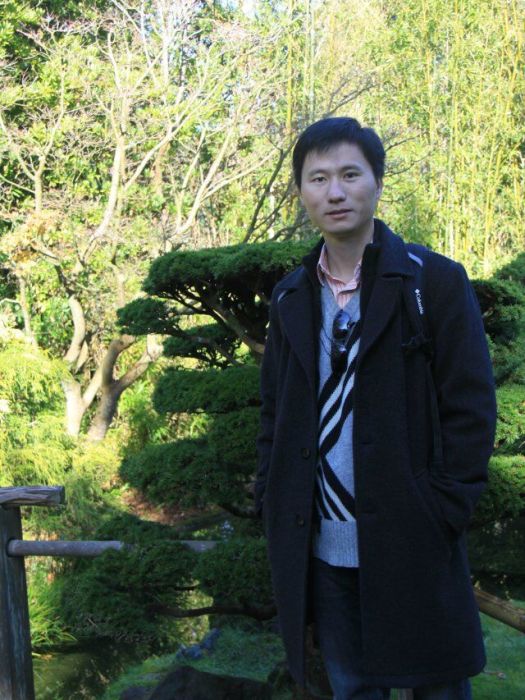樂成峰,博士,浙江大學海洋學院研究員,博士生導師。
基本介紹
- 中文名:樂成峰
- 學位/學歷:博士
- 職業:教師
- 專業方向:海洋遙感、極地氣候變化、海氣相互作用
- 就業院校:浙江大學海洋學院
研究方向,人物經歷,學術成果,科研項目,會議論文,學術論文,
研究方向
海洋遙感、極地氣候變化、海氣相互作用
人物經歷
現任職于海洋學院物理海洋與遙感研究所。2010年7月-2015年8月分別在美國南佛羅里達大學和美國環境保護總署墨西哥灣生態研究中心從事博士後研究。
學術成果
科研項目
(1)開發了內陸湖泊高渾濁水體葉綠素濃度高光譜遙感反演模型
基於現有算法的局限性,申請人開發了面向高渾濁內陸湖泊水體的葉綠素濃度高光譜遙感反演算法—四波段算法。該算法根據生物光學模型原理,利用紅色和近紅外波段的代數組合,最大程度的消除了有色可溶性有機物和懸浮物濃度對葉綠素濃度反演算法的影響,克服了現有算法的局限性,很大程度的提高了反演精度。同時,該算法為未來水色遙感衛星感測器波段的設定提供了重要的參考。該研究成果於2009年發表在國際頂級遙感期刊《Remote Sensing of Environment》上,得到國內外同行的高度認可,被獨立引用110餘次(源自google scholar)。
(2)開發了內陸渾濁水體光譜分類算法
不同水體,由於其水體組分濃度的差異,不同組分對遙感反射率的貢獻也存在著很大的差異性,從而導致水色要素遙感反演算法的普適性較差。因此,提高反演模型的普適性,是水色遙感反演研究中的一個重要難題。
申請人根據對內陸湖泊水體不同組分光學特性相互作用的機制,在對海量實測高光譜遙感反射率數據分析的基礎上,開發了基於遙感反射率的內陸渾濁水體光學特性分類算法。該算法僅以三個波段的遙感反射率作為輸入參量,利用這三個波段之間的斜率關係,將渾濁水體遙感反射率分為三大類。利用我國三湖一庫(太湖、巢湖、滇池、三峽水庫)的數據對算法進行驗證得出,該分類算法很好的解決了由光學特性差異導致水質參數反演精度不高的難題,極大程度地提高了水質參數反演算法的普適性。該研究成果於2011年發表在國際頂級遙感期刊《Remote Sensing of Environment》上,被國內外同行獨立引用40餘次(源自google scholar)。
(3)構建了基於多光譜衛星影像的近岸陸架海域葉綠素濃度遙感反演算法
利用多光譜遙感衛星影像反演近岸陸架海域葉綠素濃度的難點主要在於衛星數據波段的有限性,以及水體光學特性的複雜性。同時,大氣糾正算法的不足也對葉綠素濃度反演算法帶來很大影響。因此,利用多光譜遙感衛星數據反演近岸陸架海域的葉綠素濃度仍然是當前海洋遙感一個挑戰性的難題。多數研究者主要集中在對現有的大洋水體算法的參數調整上,部分研究者利用實測數據建立區域性經驗反演模型。以上兩類算法沒有充分考慮到近岸陸架水體光學特性與開闊大洋水體的光學差異,以及陸架海域內光學特性差異,使得遙感反演算法精度很低。
利用美國多個河口近岸陸架海域的實測數據和多光譜遙感衛星影像數據(MODIS和SeaWiFS),申請人開發了面向河口和近岸陸架海域的葉綠素濃度遙感反演耦合算法。該算法首先考慮到陸架海域區域內部,以及近陸架海域和遠陸架海域的光學特性差異,開發了基於多光譜衛星遙感反射率的光學分類方法。然後針對不同光學類型的水體,分別建立葉綠素反演模型。最後耦合不同的葉綠素濃度反演模型進行河口陸架海域的葉綠素濃度遙感反演。該算法在美國多個河口和陸架海域(如:Tampa Bay, Chesapeake Bay, Mobile Bay, Pensacola Bay, Louisiana continental shelf)得到較好套用。相關研究成果發表於國際頂級地球科學類期刊Journal of Geophysical Research: Oceans;國際頂級遙感期刊Remote Sensing of Environment, 國際著名物理海洋期刊Progress in Oceanography, Estuarine Coastal and Shelf Science上。該算法得到國際同行的高度認可,相關研究成果被獨立引用90餘次 (源自google scholar)。
(4)開發了基於多光譜衛星影像的近岸陸架海域“缺氧區”遙感提取算法
河口近岸陸架海域“缺氧區”是當前近岸海洋環境中最為嚴重的問題之一。“缺氧區”的誘因主要包括生物因子和物理因子。現階段對“缺氧區”的研究還集中在“缺氧區”面積與河流的營養鹽輸入量之間的關係上(即:生物因子)。在河口水動力環境的變化(物理因子)對“缺氧區”影響方面的研究相對較少。在“缺氧區”的預測方面的研究,主要是利用歷史實測“缺氧區”面積和河流徑流量或營養鹽輸入量之間的經驗統計關係對“缺氧區”進行預測,存在很大誤差。
針對現階段針對“缺氧區”的研究沒有考慮到物理因子的局限性,本研究根據河口羽流面積和河口水動力環境的回響關係,以河口羽流面積作為物理動力因子的間接指標,首先開發了河口羽流面積的遙感提取算法;然後,根據“缺氧區”的形成機理,結合近岸陸架海域的浮游藻類遙感反演算法和河口羽流遙感提取模型,提取近岸陸架海洋浮游藻類和河口羽流的時間序列動態變化;最後,以浮游藻類和河口羽流面積作為輸入參數,構建了河口陸架海域“缺氧區”遙感間接提取模型。該研究成果得到國際同行們高度評價,並於2016年發表在國際頂級地球科物理學期刊 Geophysical Research Letters上。
會議論文
2012 December, Scotland, Globolakes workshop,Observation of Chla from Satellites in Estuaries: A case study in Tampa Bay, USA. (Invited)
2013 December, San Francisco, AGU meeting,Land use/Land cover driven optical properties in Gulf coastal estuaries.
2014 May, Portland, Joint Aquatic Science meeting,Observation of phytoplankton dynamic in Louisiana shelf from satellites: Implication in hypoxia management.
學術論文
1.Chengfeng Le, Xueying Zhou, Chuanmin Hu, Zhongping Lee, Dariusz Stramski, Lin Li (2018). A novel empirical algorithm for determining particulate organic carbon concentrations from satellite observations in global oceans from satellite observations,Journal of Geophysical Research: Oceans, (revised)
2.Lin Li,Chengfeng Le,Jennifer Cannizzaro (2018). Remote sensing of dissolved organic carbon (DOC) from satellite observations on the West Florida Shelf,Continental Shelf Research, (revised)
3.Chengfeng Le, John C. Lehrter, Chuanmin Hu, Hugh MacIntyre, and Marcus W. Beck (2017). Satellite observation of particulate organic carbon dynamics on the Louisiana continental shelf,Journal of Geophysical Research: Oceans, 122, doi:10.1002/2016JC012275.
4.Chengfeng Le, John C. Lehrter, Chuanmin Hu, Daniel R. Obenour (2016). Satellite-based empirical models linking river plume dynamics with hypoxic area and volume,Geophysical Research Letters, DOI: 10.1002/2015GL067521.
5.Chengfeng Le, John C. Lehrter, Chuanmin Hu, James D. Hagy, Blake Schaeffer, (2016). Bio-optical water quality dynamics observed from MERIS in Pensacola
Bay, Florida,Estuarine, Coastal, and Shelf Science, 173, 26-38.
6.Chengfeng Le, John C. Lehrter, Blake Schaeffer, Chuanmin Hu, Hugh MacIntyer, James D. Hagy, David L. Beddick (2015). Relation between inherent optical properties and land use and land cover across Gulf Coast estuaries.Limnology and Oceanography,60(3):920-933.
7.Chengfeng Le, John C. Lehrter, Chuanmin Hu, Lin Qi (2014). Spatiotemporal chlorophyll-a dynamics on the Louisiana continental shelf derived from a dual satellite imagery algorithm.Journal of Geophysical Research: Oceans,119, 7449-7462.
8.Chengfeng Le, Chuanmin Hu (2013). A hybrid approach to estimate chromophoric dissolved organic matter in turbid estuaries from satellite: A case study for Tampa Bay.Optics Express, 21:18849-18871.
9.Chengfeng Le,Chuanmin Hu, Jenifer Cannizzaro, Hongtao Duan (2013). Long-term distribution patterns of remotely sensed water quality parameters in Chesapeake Bay.Estuarine, Coastal and Shelf Science, 128, 93-103.
10.Chengfeng Le, Chuanmin Hu, Jenifer Cannizzaro, David English, Charles Kovach (2013). Climate-driven chlorophyll a changes in a turbid estuary: observation from satellite.Remote Sensing of Environment, 130, 11-24.
11.Chengfeng Le, Chuanmin Hu, Jenifer Cannizzaro, David English, Lian Feng (2013). Towards a long-term chlorophyll-a data record in a turbid estuary using MODIS observation.Progress in Oceanography, 109, 90-103.
12.Chengfeng Le, Chuanmin Hu, Jenifer Cannizzaro, David English, Frank Muller-Karger, Zhongping Lee (2013). Evaluation of chlorophyll-a remote sensing algorithms for an optically complex estuary.Remote Sensing of Environment, 129: 75-89.
13.Chengfeng Le, Chuanmin Hu, David English, Jenifer Cannizzaro, Zhiqiang Chen, Charles Kovach, Christopher J Anastasiou, Jun Zhao, Kendall L. Carder (2013). Inherent and apparent optical properties of the complex estuarine waters of Tampa Bay: What controls light?Estuarine, Coastal and Shelf Science, 117 54-69
14.Chuanmin Hu,Chengfeng Le(2013), Ocean color continuity from VIIRS measurement over Tampa Bay. IEEE Geoscience and Remote Sensing Letters, 11(5), 945-949.
15.Chengfeng Le, Yunmei Li, Yong Zha, Deyong Sun, Changchun Huang, Hong Zhang (2011), Remote sensing of chlorophyll a in optically complex waters based on optical classification.Remote Sensing of Environment, 115:725-734.
16.Chengfeng Le, Yunmei Li, Yong Zha, Qiao Wang, Hong Zhang, Bin Yin (2011). Remotely sensing of phycocyanin in highly turbid inland water in Lake Taihu, China.International Journal of Remote Sensing, 23(10), 8253-8269.
17.Chengfeng Le,Yunmei Li, Yong Zha, Deyong Sun and Bin Yin (2009). Validation of a Quasi-Analytical Algorithm for Highly Turbid Eutrophic Water of Meiliang Bay in Taihu Lake, China.IEEE Transactions on Geoscience and Remote Sensing,47(8):2492-2500.
18.Chengfeng Le, Yunmei Li, Yong Zha, Deyong Sun, Changchun Huang and Heng Lu (2009). A four-band semi-analytical model for estimation chlorophyll a in highly turbid lakes: The case of Taihu Lake, China.Remote Sensing of Environment, 113: 1175-1182.
19.Chengfeng Le,Yunmei Li, Yong Zha and Deyong Sun (2009). Specific absorption coefficient and the phytoplankton pachage effect in Lake Taihu, China.Hydrobiologia, 619:27-37.
20.Chengfeng Le, Yong Zha, Yunmei Li, Deyong Sun, Heng Lv, Bin Yin (2009). Eutrophication of Lake Waters in China: Cost, Causes, and Control.Environmental Management,doi: 10.1007/s00267-010-9440-3.
21.Deyong Sun, Yunmei Li, Qiao Wang,Chengfeng Le, Heng Lv, Changchun Huang, Shaoqi Gong (2012). A novel support vector regression model to estimate the phycocyanin concentration in turbid inland waters from hyperspectral reflectance.Hydrobiologia, 680, 199-217.
22.Deyong Sun, Yunmei Li, Qiao Wang,Chengfeng Le,Changchun Huang, Lizhen Wang, Kun Shi (2011). Development of optical criteria to discriminate various types of highly turbid lake waters. Hydrobiologia, 669, 83-104.
23.Deyong Sun, Yunmei Li,Chengfeng Le, Kun Shi, Changchun Huang, Shaoqi Gong, Bin Yin. A semi-analytical approach for detecting suspended particulate composition in complex turbid inland waters (China). Remote sensing of Environment, 2013, 134, 92-99.
24.Qiao Wang, Deyong Sun, Yunmei Li,Chengfeng Le, Changchun Huang (2010). Mechanisms of remote-sensing reflectance variability and its relation to bio-optical processes in a highly turbid eutrophic lake: lake Taihu (China). IEEE Transactions on Geoscience and remote sensing, 48(1), 575-584.
25.Deyong Sun, Yunmei Li, Qiao Wang,Chengfeng Le, Changchun Huang, Lizhen Wang (2009). Parameterization of Water Component Absorption in Inland Eutrophic Lake and Its Seasonal Variability — A Case Study in Lake Taihu. International Journal of Remote Sensing, 30(13), 3549-3571.
26.Yunlin Zhang, Bing Zhang, Ronghua Ma, Shen Feng,Chengfeng Le (2007), Optically active substances and their contributions to the underwater light climate in Lake Taihu, a large shallow lake in China. Fundamental and applied Limnology/Achiv fur Hydobiologie, 170, 11-19.
27.Chuangchun Huang, Yunmei Li, Deyong Sun,Chengfeng Le. Retrieval of Microcysis aentginosa Percentage from High Turbid and Eutrophia Inland Water: A Case Study in Taihu Lake.IEEE Transactions on Geoscience and Remote Sensing, 2011, 49, 4090-4100.

